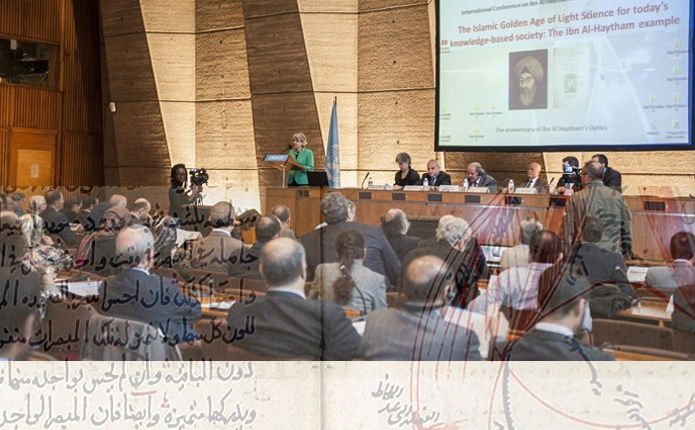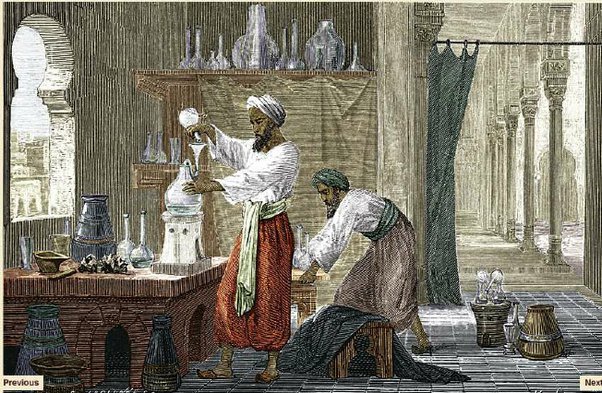The classic Golden Age of Islamic biography was an era of incredible scientific, social, cultural, philosophical, and economic buoyancy in the history of Islam, which traditionally dates from the 8th century to the 14th century CE. This Golden Era is thought to have begun during the reign of Abbasid caliph Haroon al-Rashid (786 – 809 CE) when he established the House of Wisdom in Baghdad- the biggest and the most prestigious Educational Capital of the world and the heart of remarkable Muslim scholarship which recruited renowned scholars from all over the globe including Muslims, Christians, and Jews.
They collaborated peacefully there to produce world-class intellectuals and polymaths in all the fields of knowledge-be religious studies, philosophy, biological sciences, chemistry, mathematics, physics, earth sciences, astronomy, industry, technology, law, literature, art, architecture, politics, economy, or sociology. This Islamic Empire of knowledge brought many cultures together under one umbrella beyond their races, colors, demographic distribution, or religion, which is the true essence of Islam.
Scientific Advances in Islamic Golden Age
Biology and Medicine
Bu Ali Sina (Latinized as Avicenna), is known as the father of Medicine. His contributions to biology and medical sciences have set up the profound basis of modern medicine, and his book The Canon of Medicine is still part of the operational curriculum of medical sciences in the west. He also discovered the causes of contagious diseases and introduced the concept of quarantine to limit the spread of contagious diseases; he laid the foundations of sub-fields of medicine such as experimental medicine and evidence-based medicine, trial methodologies like clinical trials, control trials, and efficacy testing.
Bu Ali Sina also introduced clinical pharmacology and separated it from medicine. His other significant contributions include the explanation of microorganisms like bacteria and viruses, research-based studies on the contagiousness of tuberculosis, water and soil-borne diseases, skin diseases (STDs), sexually transmitted diseases, perversions, and the ailments of the nervous system.
Other Muslim physicians of the golden age also have made miraculous contributions in the fields of physiology, ophthalmology, pharmacology, surgery, anatomy, pathology and medicine. With their inventive approaches, they were the pioneers in opening up hospitals, including medical schools and psychiatric clinics, the invention of surgical instruments and procedures, including dissections and postmortem autopsies, and comprehensively elaborated diagrams of human anatomy and physiology.
The notable among the best physicians and researchers of the golden age who led the edge in the field of medicine and biology are Al-Kindi, Al-Razi (Latinized as Rhazes), Abu al-Qasim (Abulcasis), Ibn Zuhr (Avenzoar), Ibn al-Nafis, Ibn al-Lubudi, Ibn Khatima, Ibn al-Khatib, Mansur Ibn Ilyas and Al Zahrawi.
Chemistry
Jabir bin Hayyan (Latinized as Geber) is known as the Father of Chemistry, who pioneered the use of the scientific method in the field of chemical sciences. He also introduced the Lusterware, alembic, retort, still, and chemical processes of filtration, distillation, crystallization, liquefaction, purification, sublimation, oxidization, and evaporation. He also has another feather in his cap of preparing sulphuric acid and nitric acid, the strongest known acids, and laid the foundation of acid-base in chemistry.
Another influential Muslim chemist of this era was Al Razi, whose contributions shook the basis of Aristotle’s and Galen’s chemistry. Invention of kerosene oil and kerosene lamps, soaps, distilled petroleum, and antiseptics experimentally proved the qualities of matter like oiliness, inflammability, sulfurousness, and salinity.
For the first time in the history of chemistry the Muslim alchemists separated the concept of organic and inorganic chemistry, they made major contributions in metallurgy and the use of acids and making salts. A huge number of laboratory apparatus was made during this golden era, and metallurgy was introduced extensively.

Physics
Some of the very basic laws of physics have been put forward by Muslim physicists of the Golden Age, like the law of inertia, momentum, the law of gravitation, and even the precursors to Newton’s laws of motion were also conceptualized by Muslims.
One of the groundbreaking inventions of the Golden Ages of Islam was the pinhole camera invented by a renowned Muslim optician Ibn Al Haitham, a polymath, in the 11th century who is also considered a pioneer of modern optics, experimental Physics and regarded as The Father of Optics due to his exceptional achievements. Ibn al Haitham also developed the methodology of the scientific method to answer scientific queries systematically.
Many inventions have been produced by Muslim engineers and inventors, like the very first flying machine was constructed by Abbas Ibn Al Firnas.
Renowned Muslim physicists of this era are Ibn al-Haytham, Bu Ali Sina, Hibat Allah Abu al-Barakat al-Baghdadi, Ibn Bajjah (Latinized Avempace), Jafar Muhammad Ibn Musa, Ibn Shakir, and al-Khazini.
Astronomy
The successors and predecessors of the Maragha School of Baghdad were thought to be the pioneers of many astronomical discoveries and inventions, including the construction of the first observatory, the evidence of Earth’s rotation on its axis, the collection of astronomical data and correction of the previous astronomical concepts, resolving considerable problems in the Ptolemaic Model, development of astrolabes, invention of numerous astronomical equipment and laying the foundations of celestial mechanics and astrophysics.
The eminent astronomy scholars of this era are Ibn Al-Shatir, Nasir Al-Din Al-Tusi, Ali Qushji, Al-Birjandi, Ibn Al-Haytham, and Mo’ayyeduddin Urdi.
Geography
The drawings and illustrations of the world map by Muslim cartographers and geographers of the golden age were so mind-blowing and accurate that they are still in use today with nominal amendments.
The famous three-meter world map designed by Al-Idrisi, an Andalusian cartographer, is regarded as the complete and calculated world description. This map was part and parcel of the travelers as it contained quite detailed descriptions of the whole Islamic world as well as Africa, the Far East and the Christian north.
Mathematics
The field of mathematical sciences owes a tremendous debt to the Islamic Golden Era. The historical achievements of Golden age Muslim mathematicians are the developments of algebra and algorithms by Muhammad Ibn Musa al Khwarizmi, spherical trigonometry, the use of decimal point notation in numerals by Sind Ibn Ali, the introduction of crypt-analysis and frequency analysis by Al Kindi.
The introduction of algebraic and integral calculus, proof by mathematical induction, analytical geometry, and formula for infinitesimal by Ibn Al-Haytham, the first confutations of Euclidean geometry and the parallel postulate by Nasir al-Din al-Tusi, algebraic geometry by Omar Khayyam, the concept of non-Euclidean geometry by Sadr al-Din, the development of symbolism in algebra by Abu al-Hassan Ibn Ali al-Qalasadi, and numerous other advances in algebra, arithmetic, calculus, cryptography, geometry, number theory, and trigonometry was the marvelous accomplishments of Golden Age Muslim mathematicians.

Technology
Many machines were invented during this era of renovation and many basic automatics were first introduced by the great Muslim inventors. Among these machines, the revolutionary crank-connecting rod system was installed in machines that converted the rotary motion to linear motion, thus raising heavy objects with much ease. This cutting-edge technology, discovered by Al-Jazari in the 12th century CE, expanded globally and became essential to everything big and small, from the bicycle to the internal combustion engine.
Agronomy & Agriculture
Arab Agricultural Revolution is a notable advancement in the field of agricultural sciences during this era. Many novel techniques of plantation and innovative methodologies were invented to yield the increased production of crop plants.
Muslim engineers introduced fossil fuels, hydropower, tidal power, and wind power to run the power mills and factories.
The development of the scientific approach to agriculture was determined by Muslim Agriculturalists and their approach was majorly based on three elements; crop rotation system, systematic irrigation techniques, and introducing the diversity of crops, which were priory cataloged according to the land type, water requirement and possible seasonal effects.
Exotic crop varieties from around the world, such as sorghum from Africa, citrus fruits from China, rice, cotton, and sugar cane from India, were introduced to the Arab soil, which generally had never experienced the growth of such plants. The experimented farming successfully imparted a sudden boost to the economy, urban growth, vegetation cover, and employment opportunities, ultimately raising the quality standards of Arab life.
Industrial Revolution
Muslim engineers introduced fossil fuels, hydropower, tidal power, and wind power to run the power mills and factories. A wide variety of mills was employed by the Muslim industrialists, including steel mills, sawmills, hullers, grist mills, stamp mills, windmills, ship mills, sugar mills, and tidal mills. By the start of the 11th century, the huge variety of mills started operating throughout the Islamic World, from Al- Andalusia, Spain, and North Africa to Central Asia and the Middle East.
Other than these, distillation technologies, the discovery of acids, pharmaceuticals, perfumery, the silk industry, textiles, weaponry, the mining of minerals, the invention of astronomical instruments, and the use of ceramics are amazing additions by Muslims. The invention of crankshafts, water turbines, the installation of gears in mills, and the concept of dams and water reservoirs to store water were also notable inventions among countless others by Muslim Engineers of this era.
These novel mechanized advancements made it possible to carry out many industrial tasks efficiently in less time, reducing manual input, which ultimately pedaled up the revolution in the industry. This whole wave of revolution was transferred very rapidly from the center of the Muslim world to Europe, Asia and Africa.
Conclusion
The struggle for learning and excellence in learning are the fundamentals of Islamic values. Our forefathers were the great harbingers of knowledge and research who led the world in all the fields of knowledge. The sky was the limit for them that’s why they are still shining. They have a profound impact on today’s education and learning. The whole western world has recognized that the scholars of the Islamic golden age were the best successors and predecessors of intellectualism the world has ever witnessed. We must follow in their footsteps to bring back the glory that once belonged to Muslims.
References:
- https://www.google.com/search?q=islamic+golden+era&oq=ISLAMIC+GOLDEN+ERA&aqs=chrome.0.0i512l2j0i22i30l2j0i390l4.5626j0j15&sourceid=chrome&ie=UTF-8
- https://www.khanacademy.org/humanities/world-history/medieval-times/cross-cultural-diffusion-of-knowledge/a/the-golden-age-of-islam
- https://islamichistory.org/islamic-golden-age/
- http://edition.cnn.com/2010/WORLD/meast/01/29/muslim.inventions/index.html
- https://www.theguardian.com/science/2010/feb/01/islamic-science
- https://www.chemeurope.com/en/encyclopedia/Alchemy_%28Islam%29.html
- https://www.thegreatcourses.com/courses/the-history-and-achievements-of-the-islamic-golden-age
Also, Read: Inspiring minds; Muslim Scientists of the modern era

Muniba Usman is a high school teacher and teaching trainer by profession. She has a BS (HONS) in Microbiology and a diploma in Textile and Fashion design. She has a strong passion for research, arts, reading and writing. She has written many scientific articles and fiction stories for children.

